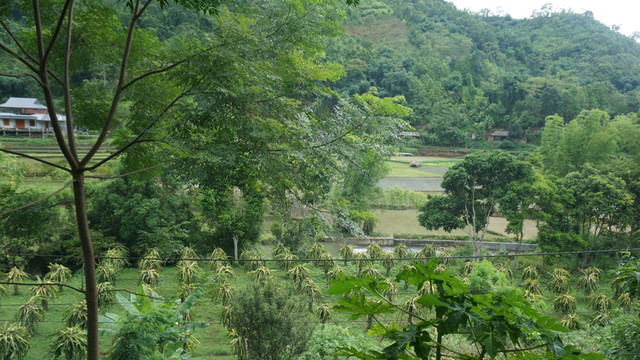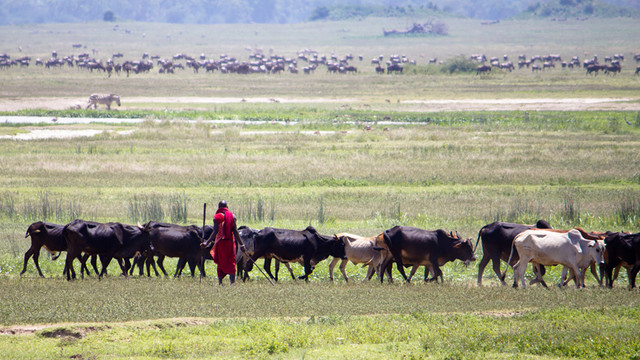Insuring against climate risk in Kenya
How can innovative approaches to disaster risk finance help communities manage climate uncertainty? Vincent Mutie Nzau, from the National Treasury of Kenya, explains.


2017: pastoralists in Isiolo county in Kenya are digging for water in dried-up river beds. Agricultural insurance schemes can help pastoralists and farmers be more resilient to climate shocks (Photo: Denis Onyodi/KRCS)
In Kenya, climate change is already having an impact. There have been 12 serious droughts since 1990, with each one affecting some 4.8 million people (PDF). The average annual costs of the damage caused are estimated at some US$1.25 billion – with each drought reducing the country's Gross Domestic Product by an average of 3.3 per cent.
The government of Kenya is keen to minimise the impact and cost of disasters to ensure the country can achieve its development goals.
Finance has an essential role to play in reducing these costs – both before and after disaster strikes. Beforehand, investment can be used to reduce risk and increase resilience, for example through flood prevention schemes or crop insurance. After shocks occur, finance is also needed to fund post-disaster recovery and long-term sustainable development. Covering these costs demands an innovative approach to disaster risk financing (DRF).
Risk management approaches
The aim of disaster risk financing is to reduce the number of people affected by shocks (such as droughts), while also preventing the cost of such disasters having a negative impact on development programmes.
Disaster risk finance takes many shapes in Kenya. Funding for DRF is allocated from Kenya's national budget, as required under the constitution. Additional finance also comes from development partners, such as the European Union, the World Bank, the African Development Bank, China and Japan, and from the private sector and charities.
This finance is accessed through various funds (such as the National Drought Emergency Fund and the EU-funded Drought Contingency Fund) via targeted projects (such the World Bank's Regional Pastoral Livelihoods Resilience project).
Kenya is one of the countries taking part in the African Risk Capacity scheme, set up by the African Union (AU). This scheme was established to improve the capacity of AU member states to plan and prepare to respond to extreme weather events and natural disasters. Kenya has been buying premiums from the scheme on a seasonal basis, effectively buying drought insurance.
Kenya also provides direct financial back-up through cash transfers as part of the Hunger Safety Net programme. This operates in four counties, providing up to 100,000 households with regular, unconditional electronic cash transfers of $25 every month. The instrument is designed to be scaled up and down in response to weather shocks.
Plans are also at an advanced stage to secure a development policy loan from the World Bank that would provide a Catastrophic Draw Down Option (Cat DDO) (PDF). This would provide a contingent line of credit allowing the government immediate access to funds in case of a disaster. If this plan goes ahead, Kenya will be the second country in Africa to obtain this kind of World Bank loan.
Kenya is leading on agricultural insurance
Kenya is also a leader within Africa in promoting participation in the emerging agricultural insurance sector.
Households can join agricultural insurance schemes to insure against the risks of drought, including schemes aimed specifically at pastoralists and drought-prone regions, and some risk-prone areas are taking out insurance at the county-level.
The Index Based Livestock Insurance scheme was developed in 2009 by the International Livestock Research Institute and insures pastoralists against the drought-related deaths of their livestock. IBLI has been financed through contributions from the UK's Department for International Development, US Aid and the European Union.
The Kenya Livestock Insurance Program is a government-run programme, launched in Turkana and Wajir counties in October 2015, with a goal to cover 14 drought-prone counties by 2017. In 2016, Marsabit, Isiolo, Mandera and Tana River counties joined the programme. Over $1.6million has been paid in premiums with a total sum insured of $10 million, benefitting 15,000 households.
The Kenyan government is planning to support the development of a voluntary livestock insurance market for pastoralists in these counties by subsidising premiums for those taking out insurance.
The government also runs the Kenya Agriculture Insurance and Risk Management Program, which provides yield index insurance for semi-commercial maize and wheat farmers, with premiums subsidised by the government. More than 950 semi-commercial maize farmers have purchased insurance so far.
Finally, Weather Index Insurance in Kenya has been subsidised by a range of international donors – which have provided $435,000 per year from 2014 to 2016.
Reducing risks, reducing impacts
While Kenya has made great strides in developing and participating in innovative schemes that manage climate and disaster risk, there is a massive DRF funding shortfall. So far Kenya has been able to mobilise around $188 million oer year in DRF. But this still leaves a gap of some $1.1 billion needed to protect vulnerable communities (PDF).
In addition, an inadequate legal framework, poor coordination, and a reliance on international donors mean that such protection is far from guaranteed.
What is needed now is more coordination across the various risk management schemes to ensure cover is targeted at the most vulnerable, and schemes are joined up to ensure all affected groups are protected. Interventions should also cover beneficiaries at all stages of the risk cycle – pre-disaster, during disaster, and post-disaster – to ensure sustainable recovery.
The government's draft policy on disaster risk management and the legislation currently being considered by the national parliament should be strengthened to improve coordination between different risk management instruments and ensure vulnerable individuals and communities get the protection they need.
A strong lead from the Kenyan government could also help secure the vital World Bank commitment on the Catastrophic Draw Down Option – and help close the $1.1 billion funding gap in disaster risk funding.
Vincent Mutie Nzau (mutie.nzau@yahoo.com) is a senior economist in the National Treasury of Kenya in the Directorate of Budget, Fiscal and Economic Affairs. He holds a masters degree in Economics from the University of Nairobi and has 10 years of policy relevant experience in the area of economic and development planning.



